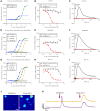Efficacy of MEDI0618, a pH-dependent monoclonal antibody targeting PAR2, in preclinical models of migraine
- PMID: 40036725
- PMCID: PMC11967467
- DOI: 10.1093/brain/awae344
Efficacy of MEDI0618, a pH-dependent monoclonal antibody targeting PAR2, in preclinical models of migraine
Abstract
Protease activated receptor 2 (PAR2) is a G-protein coupled receptor expressed in meningeal neurons, fibroblasts and mast cells that may be targeted to treat migraine. MEDI0618, a fully humanized PAR2 monoclonal antibody, engineered to enhance FcRn-dependent recycling and currently in clinical development, was evaluated in human and rodent in vitro assays, in multiple murine in vivo migraine models and in a model of post-traumatic headache. MEDI0618 bound specifically and with high affinity to cells expressing human PAR2 (hPAR2) and prevented matriptase-induced increase in cytosolic calcium. Similarly, MEDI0618 prevented matriptase-induced calcium in primary fibroblasts and microvascular endothelial cells from human dura mater. MEDI0618 had no effect on hPAR1 receptors. Single-cell calcium imaging of acutely dissociated mouse trigeminal ganglion neurons confirmed expression and functionality of mouse PAR2. Studies in vivo used evoked cutaneous allodynia as a surrogate of headache-like pain and, in some experiments, rearing as a measure of non-evoked headache pain. MEDI0618 was administered subcutaneously to C57BL6/J female mice prior to induction of migraine-like pain with (i) systemic nitroglycerin or compound 48/80 (mast cell degranulator); or (ii) with supradural compound 48/80 or an inflammatory mediator (IM) cocktail. To assess possible efficacy against CGRP receptor (CGRP-R)-independent pain, MEDI0618 was also evaluated in the IM model in animals pretreated with systemic olcegepant (CGRP-R antagonist). Migraine-like pain was also induced by inhalational umbellulone, a TRPA1 agonist, in animals primed with restraint stress in the presence or absence of MEDI0618 as well as in a model of post-traumatic headache pain induced by a mild traumatic brain injury. MEDI0618 prevented cutaneous allodynia elicited by systemic nitroglycerin, compound 48/80 and from supradural compound 48/80 and IM. Systemic olcegepant completely blocked periorbital cutaneous allodynia induced by supradural CGRP but failed to reduce IM-induced cutaneous allodynia. In contrast, MEDI0618 fully prevented IM-induced cutaneous allodynia, regardless of pretreatment with olcegepant. Umbellulone elicited cutaneous allodynia only in restraint stress-primed animals, which was prevented by MEDI0618. MEDI0618 prevented the decrease in rearing behaviour elicited by compound 48/80. However, MEDI0618 did not prevent mild traumatic brain injury-related post-traumatic headache measures. These data indicate that MEDI0618 is a potent and selective inhibitor of PAR2 that is effective in human and rodent in vitro cell systems. Further, blockade of PAR2 with MEDI0618 was effective in all preclinical migraine models studied but not in a model of post-traumatic headache. MEDI0618 may represent a novel therapy for migraine prevention with activity against CGRP-dependent and independent attacks.
Keywords: PAR2; mast cells; migraine prevention; pain; post-traumatic headache; trigeminal.
© The Author(s) 2025. Published by Oxford University Press on behalf of the Guarantors of Brain.
Conflict of interest statement
F.P. has served as a consultant or received research funding from Amgen, Acadia, Blackthorn, Teva, Abbvie, Eli Lilly, Hoba, Allergan, Ipsen, and Proximagen and is a founder of Catalina Pharma and Axon Therapeutics. D.W.D. reports the following conflicts within the past 12–36 months: Consulting: Amgen, Atria, CapiThera Ltd., Cerecin, Ceruvia Lifesciences LLC, CoolTech, Ctrl M, Allergan, AbbVie, Biohaven, GlaxoSmithKline, Lundbeck, Eli Lilly, Novartis, Impel, Satsuma, Theranica, WL Gore, Genentech, Nocira, Perfood, Praxis, AYYA Biosciences, Revance, Pfizer. Honoraria: American Academy of Neurology, Headache Cooperative of the Pacific, Canadian Headache Society, MF Med Ed Research, Biopharm Communications, CEA Group Holding Company (Clinical Education Alliance LLC), Teva (speaking), Amgen (speaking), Eli Lilly (speaking), Lundbeck (speaking), Pfizer (speaking), Vector Psychometric Group, Clinical Care Solutions, CME Outfitters, Curry Rockefeller Group, DeepBench, Global Access Meetings, KLJ Associates, Academy for Continued Healthcare Learning, Majallin LLC, Medlogix Communications, Medica Communications LLC, MJH Lifesciences, Miller Medical Communications, WebMD Health/Medscape, Wolters Kluwer, Oxford University Press, Cambridge University Press. Non-profit board membership: American Brain Foundation, American Migraine Foundation, ONE Neurology, Precon Health Foundation, International Headache Society Global Patient Advocacy Coalition, Atria Health Collaborative, Arizona Brain Injury Alliance, Domestic Violence HOPE Foundation/Panfila. Research support: Department of Defense, National Institutes of Health, Henry Jackson Foundation, Sperling Foundation, American Migraine Foundation, Henry Jackson Foundation, Patient Centered Outcomes Research Institute (PCORI). Stock options/shareholder/patents/board of directors: Aural analytics (options), Axon Therapeutics (shares/board), ExSano (options), Palion (options), Man and Science, Healint (options), Theranica (options), Second Opinion/Mobile Health (options), Epien (options), Nocira (options), Matterhorn (shares), Ontologics (shares), King-Devick Technologies (options/board), EigenLyfe (shares), AYYA Biosciences (options), Cephalgia Group (shares/board), Atria Health (options/employee). Patent 17189376.1-1466:vTitle: Onabotulinum Toxin Dosage Regimen for Chronic Migraine Prophylaxis (Non-royalty bearing). Patent application submitted: Synaquell® (Precon Health). J.E.L., P.T., A.S.W., P.N., S.P., G.M., I.G., C.D., T.C. and I.C. are employees of AstraZeneca. The other authors report no competing interests.
Figures






References
MeSH terms
Substances
Grants and funding
LinkOut - more resources
Full Text Sources
Medical
Research Materials

